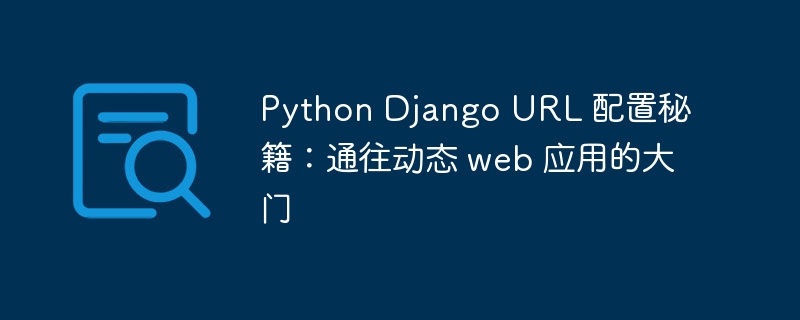Home >Backend Development >Python Tutorial >Python Django URL configuration secrets: the door to dynamic web applications
Python Django URL configuration secrets: the door to dynamic web applications
- 王林forward
- 2024-03-28 08:00:171156browse

1. URL pattern syntax
URL patterns are expressions that define the mapping between URLs and views. Its syntax is as follows:
path("<path_expression>", "<view_function_name>", name="<url_name>")
-
e024e4abbb845745107491919abbdde1: A regular expression used to match URL patterns. -
279c04271ded48dc364f10c247769aa1: The name of the view function to be called. -
9e7ae64017b2e3ed1a06ae2c6a433a7d(optional): Assign a name to the pattern so that it can be referenced elsewhere.
2. URL namespace
URL namespaces allow you to assign unique names to URL patterns in different applications or modules. This is essential to avoid name conflicts and ensure URLs are reusable.
app_name = "my_app_name" path(...), path(...),
3. URL reverse analysis
URL reverse resolution is the process of generating a URL based on its name. This is useful for dynamically creating URLs in templates or view functions.
from Django.urls import reverse
my_url = reverse("my_app_name:my_view_name")
4. Processing dynamic URL
DjanGo Allows you to handle URLs containing dynamic parts. For example, you can create a URL pattern that handles blog posts with a specific ID.
path("post/<int:post_id>/", "<view_function_name>", name="post_detail"),
5. Add prefix and suffix
Sometimes you need to add a prefix or suffix to all URL patterns in your application. This can be easily achieved using the include() function:
urlpatterns = [
path("api/", include("my_api_app.urls")),
path("admin/", include(admin.site.urls)),
]
6. Processing static files
Django provides the static() function to process static files. This separates static files from application code, improving efficiency and maintainability.
urlpatterns = [
path("static/", static(settings.STATIC_URL, document_root=settings.STATIC_ROOT)),
]
7. Customize 404 and 500 error pages
You can create custom pages to handle 404 (Not Found) and 500 ( Server Side Error) errors. This helps provide a better user experience and debug issues.
handler404 = "my_app_name.views.handler404" handler500 = "my_app_name.views.handler500"
8. Use regular expressions
Django supports regular expressions in URL patterns. This allows you to create more flexible and powerful URL matchers.
path("^category/(?P<category_name>[w-]+)/$", "<view_function_name>", name="category_detail"),
9. Debug URL patterns
Django provides debugging tools to help you identify URL configuration errors. This can be achieved by using the print_urls() function.
from django.urls import print_urls print_urls()
10. Best Practices
- Assign meaningful names to URL patterns.
- Use URL namespaces to avoid name conflicts.
- Use regular expressionsOptimize URL patterns.
- Handle dynamic URLs to support a wide range of URIs.
- Provide custom 404 and 500 error pages.
- Regularly debug URL configuration to ensure correctness.
The above is the detailed content of Python Django URL configuration secrets: the door to dynamic web applications. For more information, please follow other related articles on the PHP Chinese website!

